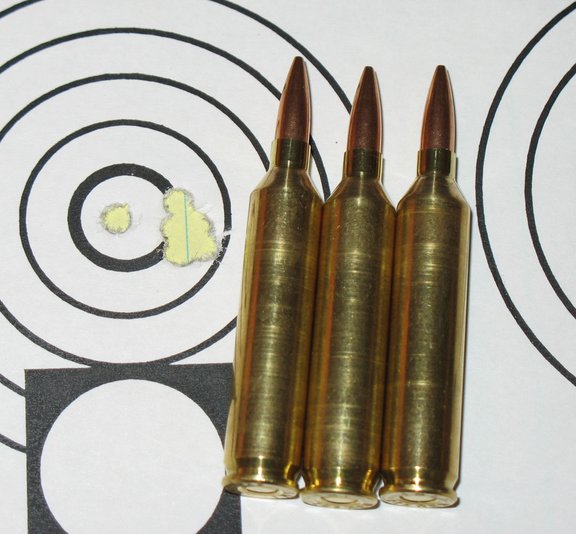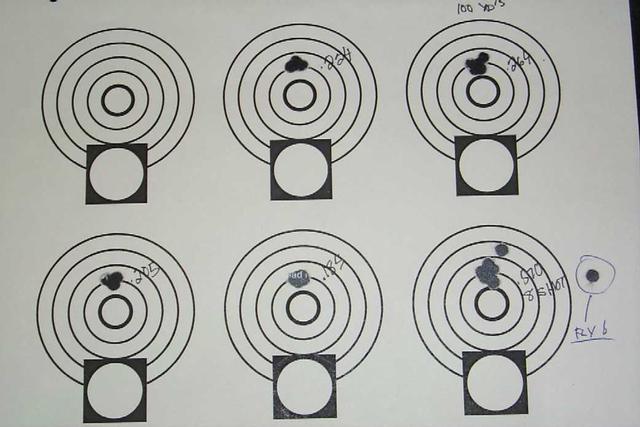Dave’s Rapid Load Development Strategy
by Dave Affleck
Here is a methodology I often use in working up a load for a new rifle. It’s not the only way to do it, heck it’s not even the only way “I” do it. And I’ve left out a lot of common variations in the interest of keeping this from getting too long. But, it does work to arrive at a good load quickly, in a logical organized manner.
Determining which powder to use is always my first step. Start by picking a good bullet – a proven performer for whatever cartridge/twist you have, Starke or Fowler 52’s for a 14 twist .22-250 for instance. Or, maybe you have a big supply of a bullet that you are bound and determined to use – in such a case finding the best powder for that bullet becomes even more important. I’ve got thousands of 50 and 55 Vmax on the shelf for instance, and often just use them and never try another bullet – just because I have so many of them. Note, if you really need to test more than one bullet, which is not unusual, always start with the heaviest bullet. That way, you can use “max” for the heavy as “starting” for the lighter ones.
Determine “jam” length (seating depth with the bullet jammed hard into the lands). If you are comfortable loading with bullets contacting the lands (I am), back off .005 from “jam” and that’s a good seating depth to start with (the bullet will still be in firm contact with the lands at .005 off “jam”). If you would feel better getting the bullet back off the lands I recommend a solid .005 off to start (I do NOT like loading at the proverbial “just kissing” point – way too indefinite). NOTE – there are exceptions to everything, but, I’ve found best accuracy is almost always found either with firm contact into the lands or not more than .010 jump (there ARE exceptions!). I’ve read from reliable sources that .22’s usually shoot best at .020 off the lands but in exhaustively testing several centerfire .22’s, I found .020 off the lands has usually been where groups really start going to shit – I don’t recommend it as a good starting point based on my own testing.
Choose some powders to test. However many or few you feel like playing with. I usually choose not less than 3 and not more than 5 powders to begin testing.
Now, here’s where my load development is much easier to do if you are setup to load at the range. Which is why I always often suggest starting out with Wilson dies and a good repeatable powder measure instead of buying an “RCBS kit”. But that’s a whole nuther ball of wax…
For each powder you want to test, begin with the “starting load” and your chosen bullet at your predetermined seating depth (just into or just off the lands but NOT “just touching”). Load one round at a time, increasing the powder charge for each case (no two will have the same powder charge). Start shooting them into a group. Keep going until you have reached “max”. Use your own judgment on what “max” is – if in any doubt, don’t go above the published data you are using. I always do this testing over a chronograph, so I’ll very quickly know what the max charge and velocity is for each powder I’m testing. Do this for each powder. After shooting this series of groups, I usually know which powder is going to work best. If shooting was done over a chrony, you’ll know how velocity stacks up for each powder. You will also have fired a “group” with each powder, I generally end up with about 10 shots in each of these groups (typically in .2 or .3 gr. increments). That’s a 10 shot group with each shot having a different powder charge. Guess what? If doing this shooting at short range, like 100 yd’s, you will very often find that one or more of the powders produced an amazingly small group for each shot having a different powder charge – I’ve literally drilled 10 shot “one holers” doing this kind of testing at 100 yards. By the same token, it’s likely that some of the powders will have really laid down shotgun patterns in this test. It’s my belief that generally speaking, the powder which produced the smallest group with each shot having a different charge weight will also produce the smallest groups when all the shots are weighed the same (as with everything else, there ARE exceptions!). Or, at least I can plainly see it’s not a temperamental combo and will be easy to work with.
Note – depending on intended application, I USUALLY like to do this testing at 300 yards or greater. Some of the data you can obtain and observe at long range is completely lost at close range. Without going into detail, simply put it this way: If you intend to use this load at 500 yards, I recommend you do this testing at 500 yards. Vertical which may not show up at all in 100 yard shooting will be way evident at 500. Also, on a related note, and again without going into great detail, strange but true: The load which gives the lowest velocity spread and SD is not always the load which gives the least vertical dispersion at long range. Moral of the story, if you intend to shoot long range, TEST long range!
So, in one whack, you have quickly determined which of the powders tested will likely give best accuracy, what the max. load is and what velocity you are getting.
From there, simply “work down” from the max load shooting groups to determine the most accurate charge weight.
Fine tuning with seating depth is a logical next step.
Primers can make a big difference, no doubt about it. But I generally don’t monkey with them except as a last resort. I’ve rarely had to go that far, but it happens.
Please note, there are about a zillion different ways to skin this cat and the method I’ve just quickly laid out here isn’t always going to be the best way. I don’t even always do it this way myself. It’s simply one of many schemes that will get you to the same destination. It’s a logical and organized methodology, but not necessarily the most logical or organized. Certainly not necessarily the best. The conditions and variables that come into play which may make it advisable to do things completely differently are so varied and vast it is impossible to even try and cover them all. Even just the variations on this methodology are virtually unlimited.
– Dave Affleck



